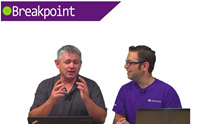DevOps in 60 seconds
Everyone is talking about DevOps these days, so I thought I would look into it and see what the hype is all about. Rather than scouring the Internet, I turned to my good friend and developer tools Guru Adam Gallant and said to him: “Adam, what can you tell me about DevOps and Visual Studio 2013 in 60 seconds or less?” Let’s just say that his answer was slightly longer than 60 seconds, but he was certainly close. Here are the answers to the questions I asked him.
What are the key trends you’re seeing for development management?
As we move into 2014, I see an growing focus when speaking to customers around increasing the integration between development teams and operations, to streamline the process of release management.
There is also a lot of interest in actionable diagnostics to support releases, understand usage patterns, and fix bugs faster (ideally, before customers even notice the bugs appearing).
And can Visual Studio 2013 help address this?
Yes, Visual Studio 2013 recently released a number of capabilities to address these scenarios. We’ve enhanced the System Center Operations Manager (SCOM) integration to support performance alerts, as well as adding new features around Application Insights and Release Management.
Release Management is new functionality in Visual Studio 2013 – what does it do?
Visual Studio Release Management allows you to better control and manage the process of releasing software into your production or live environment. You start by defining the different “environments” or stages that your software needs to move through. Then you set up the approval requirements or workflows to allow the software to move to each stage. With this you get to define and track the actual software deployment process for each stage, giving an organization complete control over their releases.
I can see why Operations will want this, but how is this going to help Dev and Test teams?
They get more visibility and more feedback. More frequent deployment of your software solutions to each of your environments means that your testers get to see the impact of software changes more immediately and measure quality much more frequently. All this allows your stakeholders to provide you with more timely and relevant feedback.
So developers can learn more from end-users, leading to more effective software?
Yes. We’ve also introduced Application Insights which further helps here. This is a new component being delivered through Visual Studio Online as an integrated analytics solution. It allows the development team to react to real-time usage trends directly from production and is integrated with the Visual Studio 2013 platform.
This can result in better quality faster, enabling you to deploy a successful build-measure-learn cycle that increases the value delivered to customers.
Since your 60 seconds is up, where should I go to learn more?
I highly encourage you to take a look at these new capabilities – implementing them will help you drive more agility and higher quality in your software solutions! You can get a better understanding of all of these new capabilities and more by watching the recorded launch event sessions, available at https://events.visualstudio.com.
And one more…Breakpoint
 Adam and I also had a chance to get into Release Management a bit on the last episode of Breakpoint we did together while we were talking about Visual Studio 2013 from an ALM perspective. We touched on Visual Studio Release Management, so when Adam mentioned it in our discussion above, it reminded me of this episode. If you haven't had a chance to check it out yet, it’s available on-demand on Channel 9.
Adam and I also had a chance to get into Release Management a bit on the last episode of Breakpoint we did together while we were talking about Visual Studio 2013 from an ALM perspective. We touched on Visual Studio Release Management, so when Adam mentioned it in our discussion above, it reminded me of this episode. If you haven't had a chance to check it out yet, it’s available on-demand on Channel 9.
Breakpoint will be back on a regular schedule, the third Friday of every month, in January, so make sure to tune in LIVE. Details will be posted on the Developer Events Hub (if you haven’t done so already, make sure you subscribe to the feed) as well as @cdndevs on Twitter (search for “#Breakpoint”).